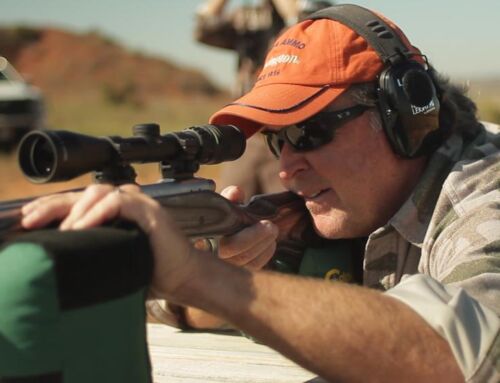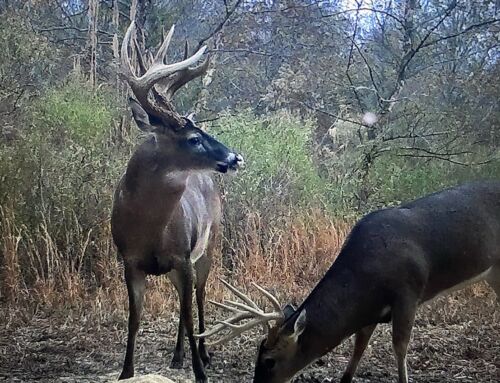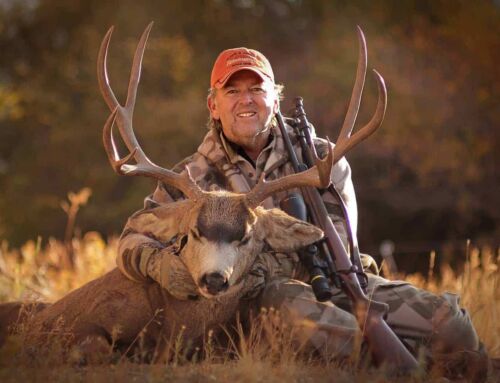 Now is a great time to try and bust a few coyotes on your land before the fawns start dropping in spring. Here’s a quick primer:
Now is a great time to try and bust a few coyotes on your land before the fawns start dropping in spring. Here’s a quick primer:
Find a Killer Setup: Look for a ridge top or hillside that overlooks a field, clear-cut, river bottom or other semi-open area. Try to set up and call where you can see well below, out to 100 or 200 yards or more. The farther you can see a coyote coming in, the more time you have to get your rifle up and prepare for the shot.
Coyote Sign: Coyote tracks are 2 to 3 inches long, with 4 toes and round pads. An adult critter’s scat is 2 to 5 inches long, round and fat. In winter, the scat will likely have hair and bone fragments from small prey in it. If you find lots of fresh tracks and scat along a field edge or in an old roadbed, look for an elevated calling spot close by and give it a go.
Get the Wind Right: Spray down with a scent-eliminator like you do when deer hunting. Walk and sneak into the wind to avoid contaminating an area with your scent before you make your first call. Try to take a straight-line route to your calling spot. Avoid wandering round and laying down scent in places where coyotes might approach your calls.
A day with a little wind, say 5 to 12 mph, is great. Many coyotes will come in to your calls from downwind, so set up for that.
Hunting with 2 guys is fun and effective. The shooter hides downwind from the caller, maybe 40 to 60 yards away depending on the setup. If a critter comes in downwind with his attention focused on the caller behind, the shooter picks him off.
Be Invisible: Gary Roberson, a predator-hunting expert from Texas, agrees that while playing the wind is most important, staying invisible is a close second. “You’ll never call in a critter that sees you first,” he says. “Try to keep the sun at your back as you sneak into a calling spot. Use the backsides of hills, ditches, deep creek bottoms and other terrains to conceal your approach.” Wear complete woods or prairie camo, and snow camo when there’s lots of snow on the ground. And be quiet. Don’t slam truck doors near a calling spot. On the walk in, go slow and easy.
Use Binoculars: Set up in a good spot, but before you start pounding on your calls, glass the countryside with 10X binos. Calling coyotes is no different than calling any game–it’s easier to lure a critter if you spot it first. Then you can call, watch the coyote and read its reaction. You’ll know whether to keep bawling to keep it moving—or to shut up and get your gun up because the predator is running in for a meal.
The Best Calls: Both electronic and mouth calls work, and there are lots of theories on using each. But the simplest and best advice I ever got was from David Hale, the game-calling legend from Kentucky. “Once you’re set up and ready, blow a rabbit-distress call for a minute or so,” he says. “Hit it good and loud. Look around; move your head slowly so a coyote coming in fast and close won’t bust you. If you don’t see anything, call for another minute, stop and look. Wait 2 to 4 minutes and call again.” Hale blows 5 sequences for good measure before he moves to a new spot. But most of the time, if a coyote is going to show, it comes to the first or second set of calls.
 Coyote Guns: The old coyote standard—a scoped bolt-action rifle in .22-250 with a 55-grain bullet—is still the best. The next 2 most popular coyote cartridges are the .223 and .243. AR-platform rifles in .204 Ruger or .223 are hot these days. And don’t forget your deer rifle. Shooting a coyote or two with your whitetail rifle in .270, 7mm-08 or whatever is fun and great winter practice. Even your .30-06 is not too big! If you hunt woods or thick cover where a coyote might bust in close, think about carrying an open-sighted 12-gauge magnum with a heavy turkey or predator load along w/a rifle.
Coyote Guns: The old coyote standard—a scoped bolt-action rifle in .22-250 with a 55-grain bullet—is still the best. The next 2 most popular coyote cartridges are the .223 and .243. AR-platform rifles in .204 Ruger or .223 are hot these days. And don’t forget your deer rifle. Shooting a coyote or two with your whitetail rifle in .270, 7mm-08 or whatever is fun and great winter practice. Even your .30-06 is not too big! If you hunt woods or thick cover where a coyote might bust in close, think about carrying an open-sighted 12-gauge magnum with a heavy turkey or predator load along w/a rifle.
Call, Shoot, Stay Ready: If you call in one coyote and shoot it, stay still and hidden, and keep calling. A lot of times coyotes travel in pairs. The second one won’t always spook from the shot, and you might be able to stop it. Try a couple of barks from a mouth call and try to pull off a double.






Hey Mike, good write up. Id also be interested in what you know about trapping. I have never been shown the ropes so to speak, but my understanding is that this is the best method in reducing coyote numbers quickly. Just another hobby that I’m sure I don’t need. Either way calling them in, is a whole lot of fun!
I know this doesnt have anything to do with coyotes. Numbers came out here for deer hunting in indiana 40 percent down and there trying to implement a new law next year for high powered rifles when is it going to stop. Im glad the insurance companies are paying the dnr to keep killing and ruining the deer hunting around here and best of all 3 people are in charge of making all these ridiculous rule changes . My money and time will be spent on going out west where there is still game to hunt. Mark this down if we dont get some help here in indiana any deer killed in this state 10 years from now will be a trophy.
Only good ‘yote is a dead ‘yote in my neck o the woods……